In What Period Did Art Serve as a Way to Teach People Who Were Illiterate About Christianity
The Medieval Fine art period covers an immense range of time and place, as it incorporates over 1000 years of art history within Europe. Having said to begin with the fall of the Roman Empire and coming to a close past the early 14th century, Medieval Art was an incredibly influential menses of Western fine art civilisation at the time. Due to its sheer span of time, many innovations and unique artifacts were made during the Medieval Art movement, with this artistic influence reaching Southwest asia and Northern Africa also.
Table of Contents
- 1 What Is Medieval Art?
- 2 A History of Medieval Fine art
- 3 Early Medieval Art
- 4 Main Divisions of Center Ages Art
- 4.i Early Christian Period
- iv.ii Byzantine Flow
- 4.3 Romanesque Menstruation
- 4.iv Gothic Period
- v Medieval Architecture
- 6 Characteristics of Medieval Art
- 6.1 Medieval Paintings
- half dozen.2 Medieval Sculptures
- vi.3 Illuminated Manuscripts
- 6.iv Stained Glass
- vii Famous Medieval Artworks
- 7.1 Hagia Sophia (built in 537 A.D.)
- 7.2 The Lindisfarne Gospels (written between 715 – 720 A.D.)
- 7.3 Palatine Chapel (built betwixt 790 – 805 A.D.)
- vii.four Notre Matriarch de Paris (built between 1163 – 1345 A.D.)
- 8 Literature from Heart Ages Art
What Is Medieval Art?
Originating in Northern Europe later the Roman Empire complanate, Medieval Art included some of the most major art movements and periods known to develop within art history. Influenced by the artistic heritage of the previous Roman era and the iconographic customs of the early on Christian Church, the Medieval period existed as an amalgamation of these artistic heritages.
Due to this fusion of styles, Medieval Art essentially went on to produce some incredibly iconic artworks due to the distinct artistic style that developed.
Due to the vastness of the Medieval Art period, the movement can more often than not be divided into a number of singled-out periods and styles. These art phases accept come to be seen as Early Christian Art, Byzantine art, Pre-Romanesque and Romanesque art, and Gothic fine art. In addition to these various styles, each region within Europe exhibited an artistic mode in a very distinct way, significant that some Medieval Art pieces varied profoundly from region to region despite being created within the same fourth dimension menstruation.
 Painted wooden ceiling of the Oude Kerk (church) in Amsterdam; Hans A. Rosbach/CC-Past-SA 3.0, CC Past-SA 3.0, via Wikimedia Commons
Painted wooden ceiling of the Oude Kerk (church) in Amsterdam; Hans A. Rosbach/CC-Past-SA 3.0, CC Past-SA 3.0, via Wikimedia Commons
Medieval Fine art was made up of diverse artistic mediums, such as sculpture, illuminated manuscripts, stained glass, tapestries, mosaics, and metalworks. Numerous artworks were made using these different styles, which went on to have a higher survival charge per unit than other mediums like fresco wall paintings. Notwithstanding, in the early on Medieval art period, works that were more decorative and made use of things like precious metals, ivory carvings, enamel, and embroidery were idea to be more valuable than traditional paintings and sculptures.
Artworks created in the Medieval era became renowned for their utilize of valuable and precious materials, which went on to get a constant characteristic of the period. The Medieval Art era eventually came to an end with the emergence of the Renaissance period of art, which saw a recovery of the skills and values associated with classical fine art that had been scorned for some centuries.
Due to the achievements of the Medieval period, it has come to exist regarded equally an enormous developmental phase for time to come Western art forms that afterward emerged.
A History of Medieval Fine art
Medieval Art inside Northern Europe grew out of the aesthetic heritage left by the Roman Empire. After its dissolution in 476 A.D., the period leading up to the emergence of Medieval Art was seen as an incredibly formative fourth dimension in the continent's creative history. Lasting until the early on stages of the Renaissance in the 14th century, Medieval Art encompassed many diverse forms of media. Thus, the history of Medieval Art is said to be very expansive as the movement lasted for numerous centuries and covered a wide range of genres.
Prominent in European regions, as well every bit the Heart East and North Africa, the Medieval Art menstruation produced some artworks which are considered to be the world's well-nigh valuable pieces today. These artworks were predominantly featured in churches, cathedrals, and other sacred doctrines and places of worship. Artworks using gold, such every bit gold leaf in religious manuscripts, was popular during the Medieval era, equally the motility was greatly influenced past the early stages of Christian fine art and the "barbarian" culture of Northern Europe.
 Book cover of the Coronation Evangeliar, part of the Royal Regalia of the Holy Roman Empire (HRE), past Hans von Reutlingen, c. 1500;Hans von Reutlingen, Public domain, via Wikimedia Commons
Book cover of the Coronation Evangeliar, part of the Royal Regalia of the Holy Roman Empire (HRE), past Hans von Reutlingen, c. 1500;Hans von Reutlingen, Public domain, via Wikimedia Commons
The development of Medieval Art produced a various range of creative styles and periods, equally the different artworks created were based on their location inside Europe. Due to the diverseness of styles emerging, the Eye Ages fine art period can generally be divided up into three singled-out phases. These are the Byzantine Art era, the Romanesque Art era, and the Gothic Art era.
The majority of the art produced during the Medieval period was religious in nature and fabricated use of Cosmic subjects and themes.
Also referred to as the Middle Ages, the Medieval catamenia was dominated past feudalism inside society. Feudalism existed equally the dominant social structure in Medieval society at the time, where nobles effectively held control over and ruled all of the lands. Society was made up of the richest members and peasants, who were forced to answer to the nobles controlling their land.
The daily lives betwixt these two social groups were thus vastly different, as the upper-class experienced wealth, power, and condition, while the lower class were expected to serve others. Due to this, a distinction existed between the two, which was only bridged by the presence of organized religion. This was why many individuals of the early Heart Ages were priests and monks in addition to existence artists, every bit faith played a major function in daily life within the Medieval period.
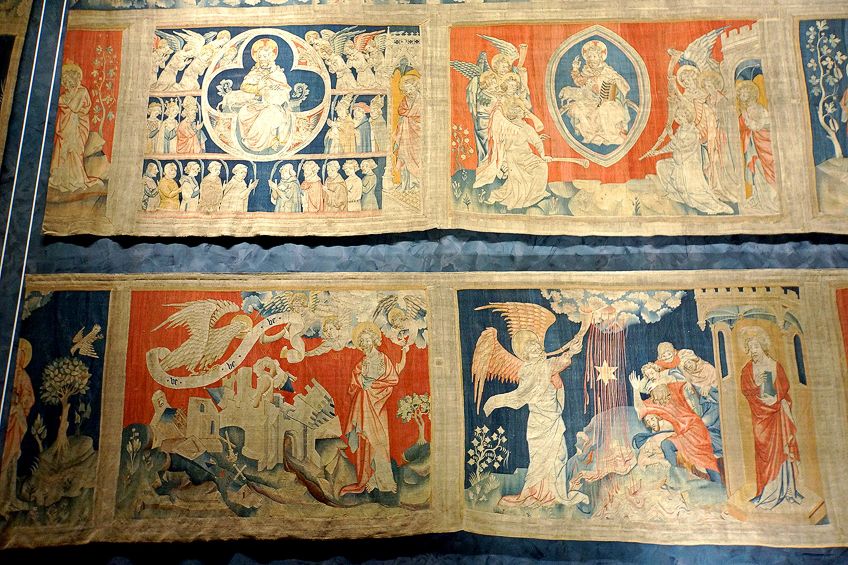 The Apocalypse Tapestry is the oldest surviving set of tapestries of this size, 100m (328ft). It was deputed in 1375 by Louis I, Duke of Anjou and blood brother of King Charles V. The tapestry took seven years to make and is made entirely of wool. Each slice starts with a major figure followed by two rows of seven scenes between a strip of sky and strip of earth;Dennis Jarvis from Halifax, Canada, CC By-SA 2.0, via Wikimedia Commons
The Apocalypse Tapestry is the oldest surviving set of tapestries of this size, 100m (328ft). It was deputed in 1375 by Louis I, Duke of Anjou and blood brother of King Charles V. The tapestry took seven years to make and is made entirely of wool. Each slice starts with a major figure followed by two rows of seven scenes between a strip of sky and strip of earth;Dennis Jarvis from Halifax, Canada, CC By-SA 2.0, via Wikimedia Commons
The early Medieval art pieces that were created were used as the main method of communicating accounts of a Biblical nature to society, as a rise in illiteracy during this time menses was experienced. This resulted in the necessity for fine art to express complicated narratives and symbolism in a fashion that was accessible to all of guild. As a upshot of this, Medieval Fine art pieces became more stylized, as the genre lost the classical naturalism associated with the Graeco-Roman times for most of the movement.
Due to this lack of literacy, printed materials became increasingly bachelor to monks and nuns who began to re-create illuminated manuscripts and so as to communicate with the masses, with these manuscripts becoming art forms themselves. Narratives of a Biblical nature were predominantly favored, as focus shifted from producing naturalistic images to being able to express circuitous stories. This also influenced the style of the movement as a whole, which began to lean towards the inclusion of abstracted figures within much of early Medieval Fine art.
Therefore, art produced within the Medieval menses consisted mainly of architectural designs of churches, castles, and monasteries, in addition to paintings, sculptures, and manuscripts.
Medieval artists worked aslope accomplished craftsmen such equally carpenters, woodcarvers, masons, metal workers, sculptors, and painters when applying ornamental features to their artworks. These works influenced artisans of lesser-known arts, like blacksmiths, locksmiths, shoemakers, and weavers, who imitated the Medieval fashion in the objects they manufactured.
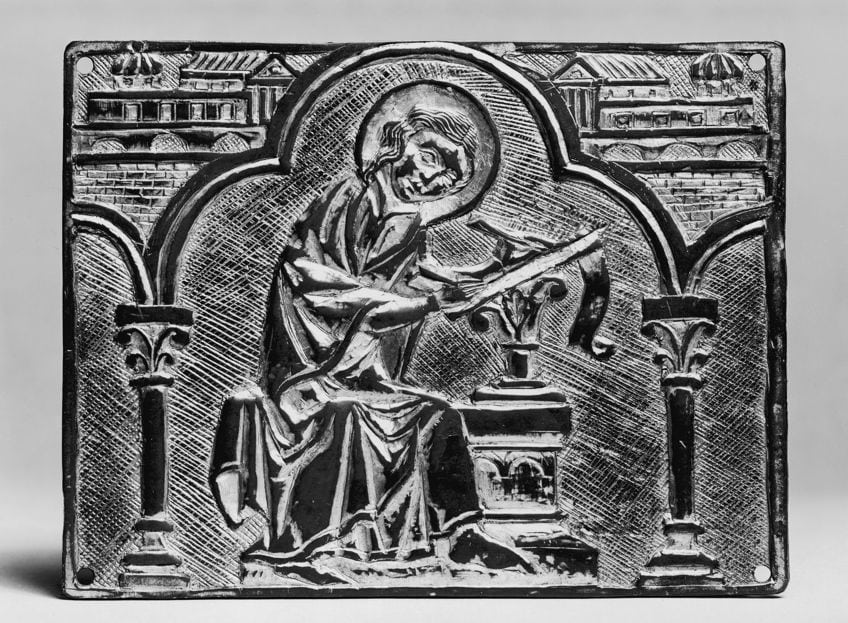 Reliquary Plaque of an Evangelist.This bas-relief engraved plaque depicts an evangelist seated within an arcade. It was role of the 13th-century redecoration of the 11th-century "Saint Amandus Shrine";Walters Art Museum, Public domain, via Wikimedia Commons
Reliquary Plaque of an Evangelist.This bas-relief engraved plaque depicts an evangelist seated within an arcade. It was role of the 13th-century redecoration of the 11th-century "Saint Amandus Shrine";Walters Art Museum, Public domain, via Wikimedia Commons
What fabricated the Medieval Art menstruum so of import was that it was non purely aesthetic, but it likewise existed as a symbol that declared ane's condition, identity, pedagogy, and culture. Thus, the major societal, cultural, and artistic changes that occurred in Europe equally the Medieval period developed went on to farther define the artworks produced during that time. While the movement neither began nor ended at a precise date, the end of Medieval Art was thought to be signaled past the changes in fine art that accompanied the start of the Renaissance period.
As the period generated a large quantity of art that was seen to be historically significant, the Medieval era continues to be a significant expanse of study for art critics, students, and collectors. The accomplishments of artists during the movement have gone on to profoundly influence the evolution of modernistic genres of Western art that have since emerged.
Thus, it can be said that the Medieval Art period exists as one of the most significant art movements in history.
Early on Medieval Art
The period of time that has been classified every bit early Medieval Art is quite complicated, every bit it includes artworks that range from the 5th century CE all the way through to grand CE. In addition to this, early Medieval artworks demonstrate a diverse cultural influence, which combined classic Greek and Roman artistic components with Christian field of study matter and decorative designs taken from the infidel N.
At the fourth dimension of the emergence of early Medieval Art, the Catholic church building and other wealthy patrons began to commission projects for detail social and religious ceremonies. Medieval artists were required to create artworks that featured Biblical tales and classical themes for churches, while the insides were intricately adorned with Roman mosaics, elaborate paintings, and marble incrustations. Due to the religious influence, many of the oldest examples of early Medieval Art remain in Roman catacombs or burials beneath cities.
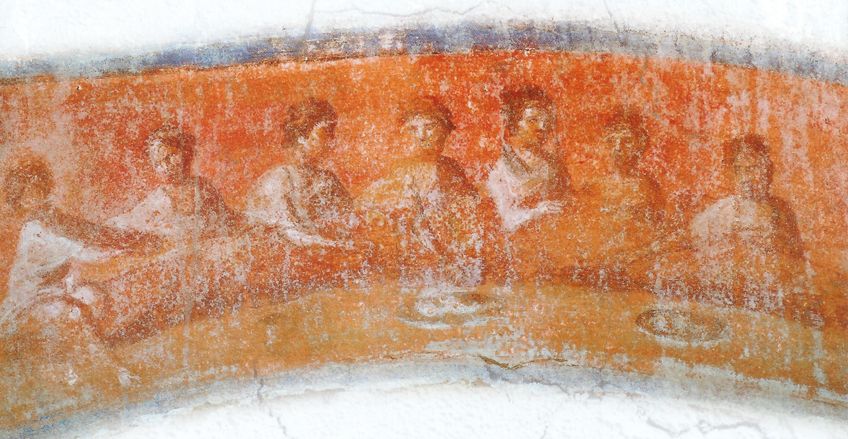 Fresco of a Christian Agape feast showing the fractio panis , the breaking of the bread during the meal of Holy Communion. Greek chapel, Catacombe di Priscilla, Rome. 2nd – fourth century;Unknown author Unknown author. Photographer: André Held, akg-images., Public domain, via Wikimedia Commons
Fresco of a Christian Agape feast showing the fractio panis , the breaking of the bread during the meal of Holy Communion. Greek chapel, Catacombe di Priscilla, Rome. 2nd – fourth century;Unknown author Unknown author. Photographer: André Held, akg-images., Public domain, via Wikimedia Commons
Many artistic styles that existed before the emergence of early Medieval Art continued to be referred back to for inspiration. A popular fine art grade that was used as the Medieval period progressed was the cosmos of relief sculptures. These sculptures were influential, every bit they stood out from their backgrounds to create a three-dimensional issue. Medieval artists used ivory as their primary medium and sculpted circuitous designs on book covers, caskets, panels, doors, and devotional items.
Another artistic form that artists continued to conserve were frescoes and mosaics, which were used to decorate churches and palaces. Both of these mediums were intricately designed and were used to portray Christian saints and scenes, such as the Blessed Virgin Mary and the rise of Jesus. A vast lack of realism accompanied these creations, with fresco paintings appearing to exist particularly apartment in style with incredibly somber subjects.
 Duomo di Siena (Siena Cathedral), a medieval church in Siena, Italy, defended from its earliest days as a Roman Catholic Marian church, and now dedicated to Santa Maria Assunta (Holy Mary, Our Lady of the Assumption);Chenspec, CC By-SA 4.0, via Wikimedia Eatables
Duomo di Siena (Siena Cathedral), a medieval church in Siena, Italy, defended from its earliest days as a Roman Catholic Marian church, and now dedicated to Santa Maria Assunta (Holy Mary, Our Lady of the Assumption);Chenspec, CC By-SA 4.0, via Wikimedia Eatables
Churches and palaces that were decorated using both relief sculptures, frescoes, and mosaics became a common sight in the early Medieval Art world. While the blueprint of these buildings remained predominantly Roman, the artistic style had a definitive Christian influence.
Still, while early Medieval Art preserved some forms and techniques from the past, such equally stylistic elements taken from the Classical globe, the motion likewise began to develop new forms and styles that went on to permanently alter the art world.
Main Divisions of Eye Ages Art
The Medieval Art period lasted for x centuries and covered an enormous scope of time and place, which meant that many dissimilar styles and forms of fine art were experimented with and included. As religion and faith were seen as the way of life during the Middle Ages, artworks that were created expressed various social, political, and historical events through the edifice of churches in about European towns.
Generally, Medieval Art is divided upwards according to the singled-out types of artworks that were created, which were expressed differently in different regions and at different times. These separate fine art periods have collectively been agreed on to be the Early Christian menstruation, the Byzantine period, the Romanesque period, and the Gothic catamenia.
Early Christian Period
Every bit early Medieval Fine art began to develop, organized religion and Christianity proved to be major influences of the movement. The majority of the artworks contained holy and spiritual references, every bit the discipline matter tended to portray Biblical scenes. To some extent, countries adjoining the Eastern Mediterranean region helped the Early Christian period of art in its development. However, the primary surface area where this period of art emerged was central Italy.
 Particular of the Gilt Madonna of Essen, 990 A.D.; Martin Engelbrecht, CC BY-SA iii.0, via Wikimedia Commons
Particular of the Gilt Madonna of Essen, 990 A.D.; Martin Engelbrecht, CC BY-SA iii.0, via Wikimedia Commons
Early Christian fine art forms developed later on the Roman Empire officially adopted Christianity every bit their ruling religion. Around the fourthursday century, Christian art grew in popularity as pictures of Christ became more than common. Concerns existed around creating images of the Deity began to abound, with more Medieval artists beginning to create scenes that depicted Jesus and other religious figures.
Sadly, as the Early Christian art period appeared at the start of the Medieval Art era, very few sacred artworks and designs have managed to survive the first three centuries of Christian art. About of the Early Christian artworks that exist today, such every bit iconic paintings, come from catacombs. Despite this, some examples of Early Christian architecture remain, as numerous churches were constructed during this period of art.
Byzantine Period
Developing in Constantinople, the upper-case letter of the Roman Empire at the time, was the Byzantine flow of art. The beginning of the Medieval era was considered to be the Dark Ages, with Byzantine fine art existing as the primary type of art used by artists from the Eastern Roman Empire. The Byzantine art period is often considered to make upwards the best artworks that were created during the Middle Ages due to the impeccable adroitness and quality of materials used.
 Cambrai Madonna (c. 1340);Cambrai Cathedral, Public domain, via Wikimedia Commons
Cambrai Madonna (c. 1340);Cambrai Cathedral, Public domain, via Wikimedia Commons
Byzantine art, which was fabricated upward of a combination of Roman and Oriental arts, was characterized past its complete lack of realism. Artists did not attempt to brand their paintings seem realistic, as they instead concentrated on the symbolism that was nowadays in their artworks. Thus, the paintings produced were incredibly apartment with no shadows, with subjects that appeared to be very serious and grim.
The bulk of the subjects within Byzantine art were religious, with many Medieval paintings being depicted of Christ and the Virgin Mary.
Architecture during the Byzantine menstruum was typically grandiose and dazzling, as buildings demonstrated the wealth and intellectual prowess of their designers, artists, and builders. This is why churches built during the Byzantine period were magnificent, equally they represented the dominating faith of Christianity in add-on to these qualities. Unfortunately, most of the artwork created during this period has since been destroyed, along with the exquisite mosaics and fresco paintings that adorned the churches.
Romanesque Menstruum
Kickoff with a phase that was known every bit pre-Romanesque art, the Romanesque menstruum developed effectually 1000 A.D. and was influenced by both the Romans and Byzantine fine art. The Romanesque period placed its focus on faith and Christianity, with these influences being seen in the artworks that were created. Typical Romanesque fine art pieces included stained glass pieces, engravings on buildings and columns, big murals on walls and domed ceilings, illuminated manuscripts, and sculptures.
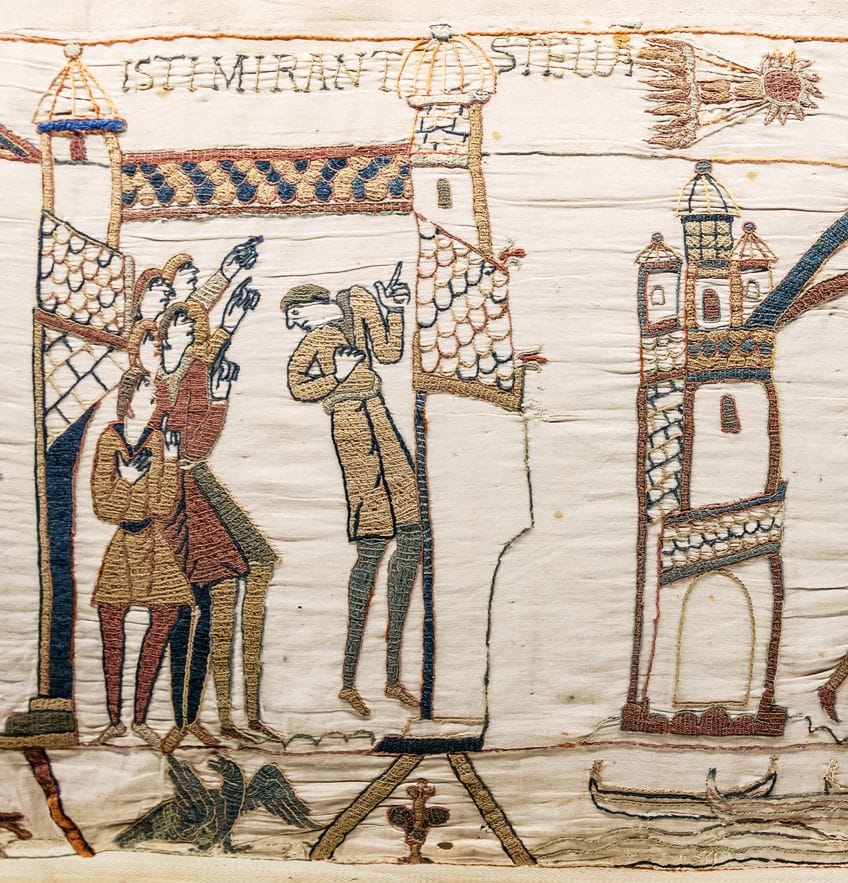 Bayeux Tapestry (1070s), scene 32 – men staring at Halley's Comet;Myrabella, Public domain, via Wikimedia Commons
Bayeux Tapestry (1070s), scene 32 – men staring at Halley's Comet;Myrabella, Public domain, via Wikimedia Commons
Romanesque buildings were enormous, powerful, and foreboding in advent, but were characterized past their unproblematic surface adornments that showcased the simplistic fashion of life of the artists. Structural forms during this period were based on artists' bones interpretations of Roman architecture, as the elements and characteristics nowadays in this art menstruation were taken specifically from ancient Rome. This stylistic influence was why the era was dubbed the "Romanesque" menses.
The styles utilized by the Romanesque flow were adult in French republic before they spread to other Western regions such as Spain, Frg, and Italia. Information technology existed as the foremost art style to disperse throughout Europe, which demonstrated the increasing affluence of European cities and the authorization of church monasteries. The Romanesque style eventually made its manner over to England where it became known as Norman fine art and continued to develop until the emergence of the Gothic Art period.
Gothic Period
The final period of late Medieval Fine art was the Gothic art period, which began developing in the 12th century. Growing out of Romanesque art, the Gothic period emerged when the Abbey Church of Saint-Denis in France was being renovated. The style began to grow in popularity and spread all over Europe, somewhen replacing Romanesque fine art entirely.
Gothic art was characterized by the use of brighter colors, dimensions, and perspective, as it demonstrated a pointed move back towards realism.
Artists began to utilise more shadows and light in their artworks and experimented with broad and new subject matters. Religion was dropped equally the most important element within art, as these new subject matters included animals and mythic scenes. Figures depicted within the Gothic period fabricated use of more than realism, as paintings became more lifelike.
 St. Aegidius and the Hindu (c. 1500) by Master of St. Aegidius;National Gallery, Public domain, via Wikimedia Commons
St. Aegidius and the Hindu (c. 1500) by Master of St. Aegidius;National Gallery, Public domain, via Wikimedia Commons
As cities began to aggrandize, the rise in universities, trade, and creation led to the formation of an entirely new grade who could suddenly beget artistic commissions. This ultimately allowed Medieval artists to explore more earthly and non-religious themes and subject matters in their artworks. Gothic architecture presented some revolutionary structural advancements to buildings, which were used to create taller and lighter buildings.
Similarly, sculpture inside this era borrowed elements from architecture and was mainly used to decorate the facade of cathedrals and other religious buildings. Gothic art eventually morphed into the Renaissance period, as elements began to mix together as the artistic catamenia changed.
Medieval Architecture
During the Medieval Art period, architecture formed an of import part of the creative developments. The Middle Ages was an era where political order was practically non-existent, which left many mutual individuals with no hope in their lives and very little to alive for. The only certainty that existed was the promise of peace in heaven, where happiness and hope would finally be experienced.
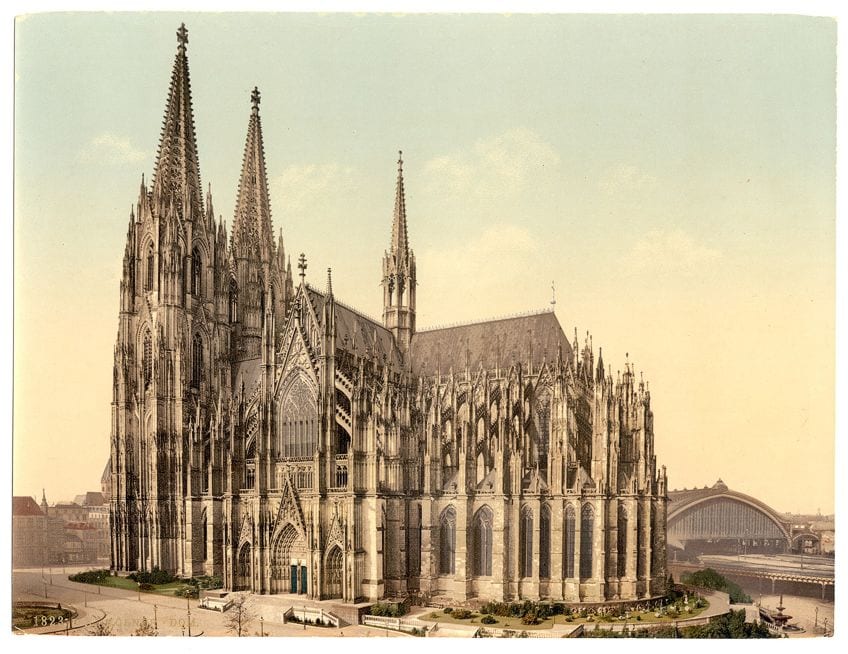 The cathedral, side, Cologne, the Rhine, Germany;See page for author, Public domain, via Wikimedia Commons
The cathedral, side, Cologne, the Rhine, Germany;See page for author, Public domain, via Wikimedia Commons
The influence of religion led to churches beingness designed by members of the public as opposed to the clergy, which immune these holy places to meet the requirements of the daily lives of its members. Thus, churches during the Medieval era took on the role of libraries, museums, and picture galleries in addition to being places of worship.
This led to churches becoming the center of town life inside the Medieval period. The architectural designs of this time illustrate the deep passion and idealism of the Christian and Catholic religion, which was represented in the churches built.
These buildings existed equally a direct expression of the spirituality of order at the fourth dimension, with the interior décor demonstrating the eager declaration of the deep religious faith of the people during the Eye Ages.
Characteristics of Medieval Art
Due to the vastness of the Medieval menses, many dissimilar types of mediums were experimented with. The artworks that still remain in large quantities include sculpture, illuminated manuscripts, tapestries, metalwork, stained glass, and mosaics. These art forms were all said to have higher survival rates than fresco wall paintings and works made out of precious metals, despite them existence extremely popular during Medieval Art. Beneath, we volition talk virtually some of the most meaning mediums of Medieval Fine art and their characteristics.
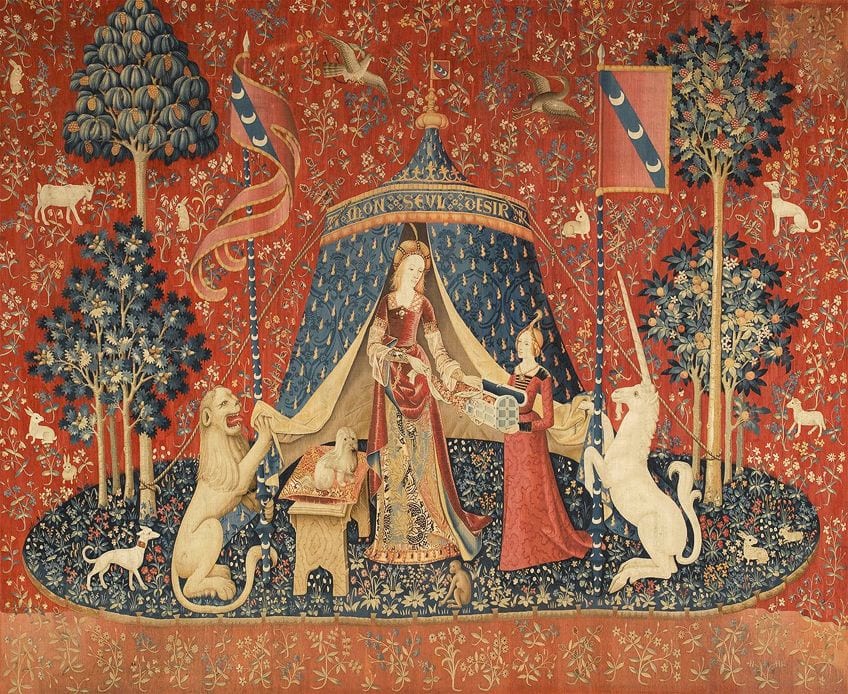 La Dame à la licorne(The Lady and the Unicorn), besides called the Tapestry Cycle, is the championship of a serial of six Flemish tapestries depicting the senses. They are estimated to have been woven in the late 15th century in the fashion of mille-fleurs;Unknown author Unknown author, Public domain, via Wikimedia Eatables
La Dame à la licorne(The Lady and the Unicorn), besides called the Tapestry Cycle, is the championship of a serial of six Flemish tapestries depicting the senses. They are estimated to have been woven in the late 15th century in the fashion of mille-fleurs;Unknown author Unknown author, Public domain, via Wikimedia Eatables
Medieval Paintings
During the Middle Ages, religion went on to get a prevalent theme in the bulk of the artworks that were produced. Vibrant paintings that featured famous icons, such every bit Jesus and the Virgin Mary, were common during the early stages of the Medieval period. One of the nearly iconic religious paintings created during this time was Final Supper by Giotto di Bondone, painted in 1306. This painting portrayed Jesus surrounded by his apostles, which went on to become the nigh depicted religious scene in fine art history.
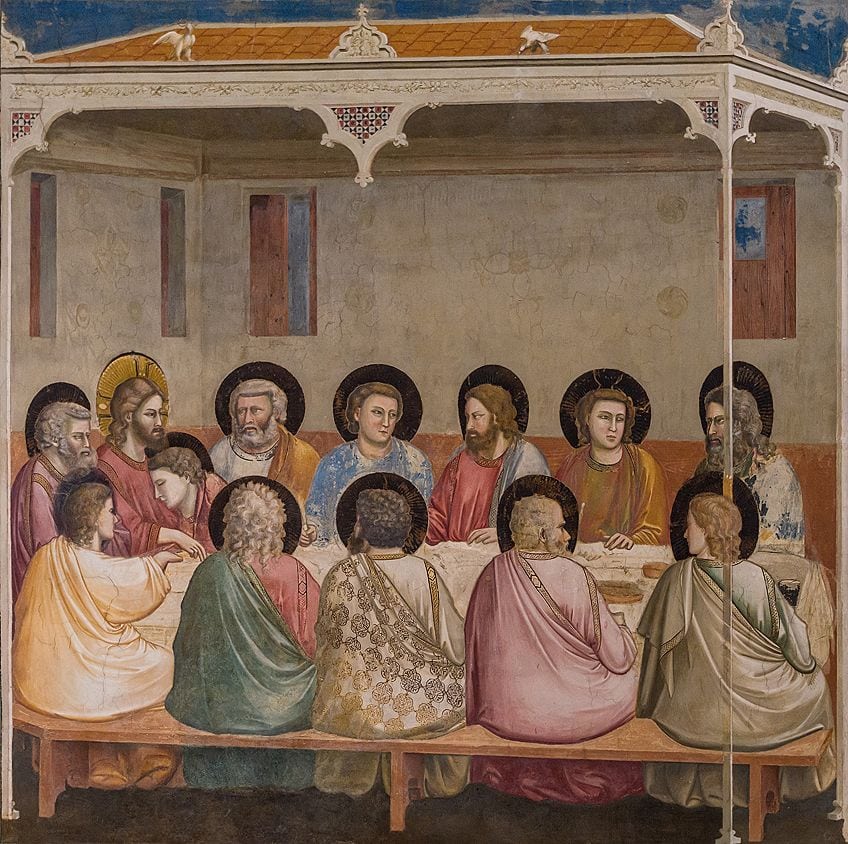 Terminal Supper (1304-1306) by Giotto di Bondone;Giotto di Bondone, Public domain, via Wikimedia Commons
Terminal Supper (1304-1306) by Giotto di Bondone;Giotto di Bondone, Public domain, via Wikimedia Commons
However, by the time the Gothic art period came effectually, artists began to stray away from the inclusion of typical religious themes in their artworks. This meant that the discipline matter began to change, along with the art fashion, equally paintings started to focus on mythology, animals, and various other themes that differed from the norm. One item artistic chemical element that artists began to adopt within their artworks was realism, which became an important feature in the paintings created during the Medieval phase.
Medieval Sculptures
The inclusion of realism also featured within the Medieval sculptures that were created. Prior to the fall of the Roman Empire, sculptures were traditionally stylized in their features. After the empire collapsed, realism was ushered in past the Ottonians and Carolingians, who emphasized the utilise of realistic aesthetics over the apathetic expressions that were used in periods such equally the Byzantine era.
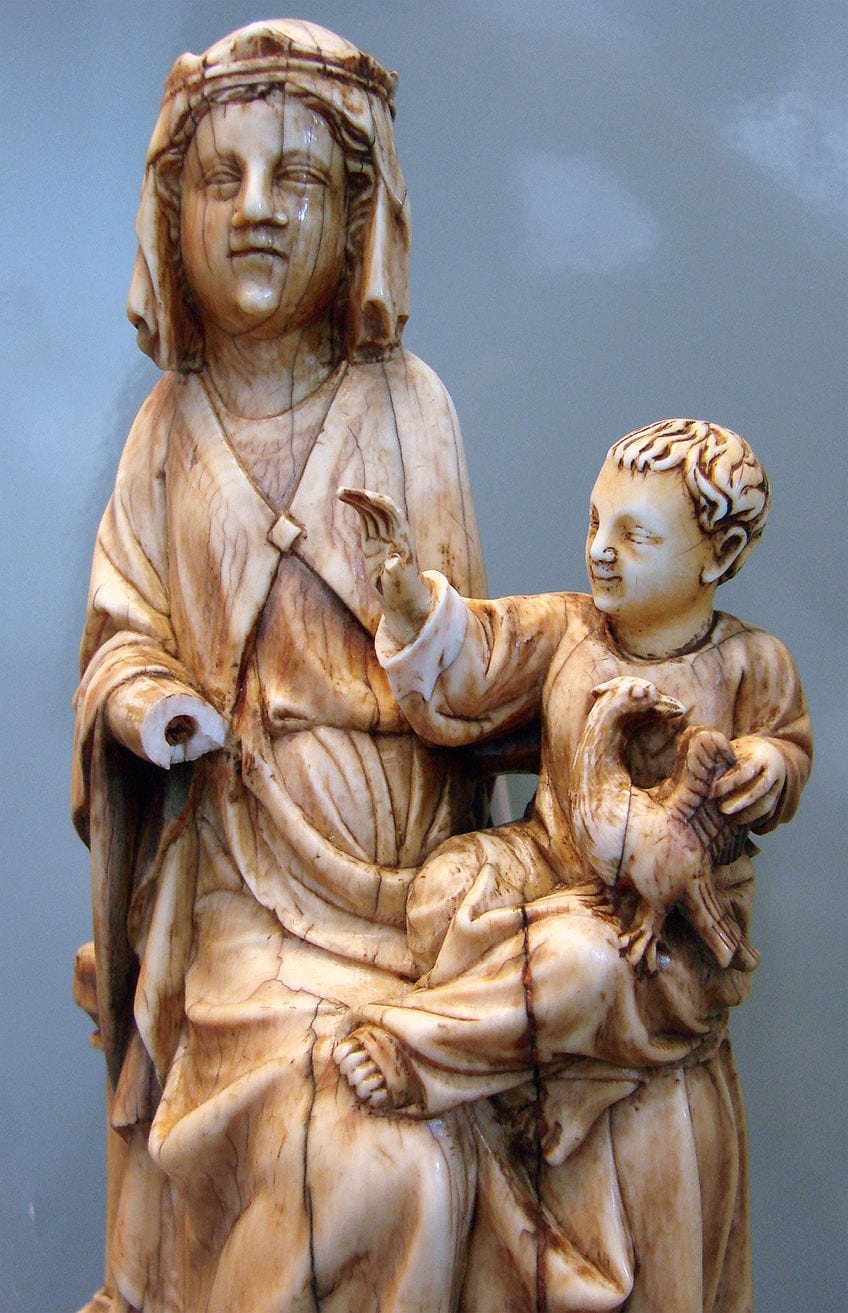 Virgin and Child, ivory, first half of the 14th century; Vassil, Public domain, via Wikimedia Commons
Virgin and Child, ivory, first half of the 14th century; Vassil, Public domain, via Wikimedia Commons
This transition into realism began a significant period of cultural revival inside Medieval Art. Exquisite ivory carvings began to re-emerge, along with statuary castings that had iii-dimensional details. These sculptures were influenced by classical realism that had exceeded previous fine art movements and had establish expression during the Medieval phase.
Due to the vastness of Medieval Art, many styles and types of sculpture came and left, which accounted for the different architectural sculptures found within the Romanesque and Gothic periods.
Prominent Medieval sculptures included the figures that decorated the exterior of famous churches, as well equally carvings of the Virgin Mary. The size of sculptures also denoted the wealth of individuals, with total-scale alabaster tombs existing as signs of excessive affluence, while smaller ivory sculptures were seen as merely devotional objects.
Illuminated Manuscripts
An art form that rose in popularity during the Medieval era was illuminated manuscripts, which featured documents of adorning text and ornamental objects. In the art athenaeum today, the bulk of the surviving illuminated manuscripts come from the Medieval phase of art.
The cosmos of illuminated manuscripts was an expensive and complicated process, as it began with writing the text onto sheets of parchment paper. Once this was completed, a lengthy stage of planning began, whereby the bare spaces within the layout were used for decoration. Inside the last step, stunning figures were painted onto these pages and frequently made utilize of gold, which was a favored color in the earliest manuscripts that were created.
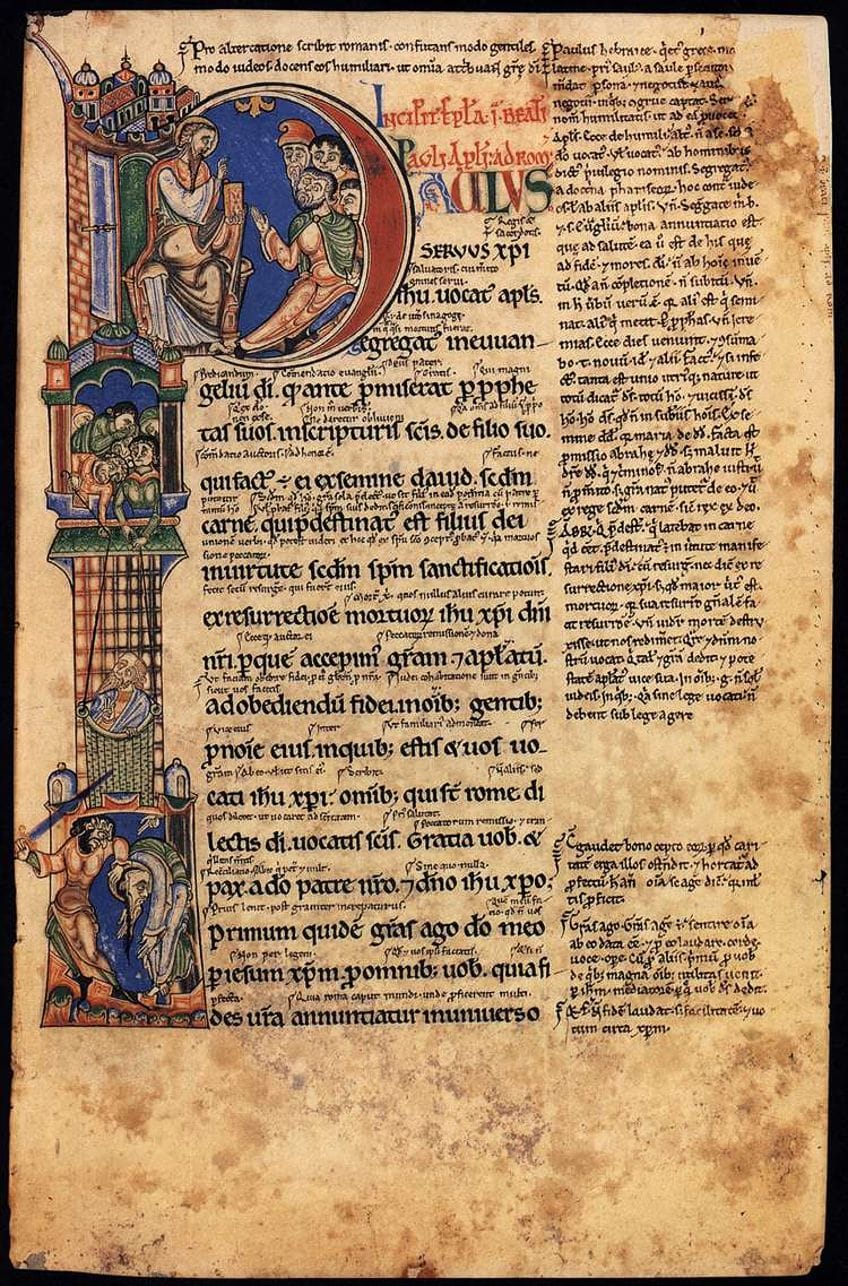 Epistles of St Paul with Gloss (c. 1150), illumination on parchment;Bodleian Library, Public domain, via Wikimedia Commons
Epistles of St Paul with Gloss (c. 1150), illumination on parchment;Bodleian Library, Public domain, via Wikimedia Commons
Due to the vast development of illuminated manuscripts, a unique mode that emerged was the creation of the historiated alphabetic character. This was an enlarged, often decorated letter of the alphabet used at the start of a paragraph and other sections of text that typically contained a picture. This was first seen in Insular Art before condign increasingly pop during the Romanesque period.
The production of illuminated manuscripts had a neat influence on the evolution of art, with these decorative initials being seen in antique-inspired books of myths and legends today.
Stained Glass
Some other stunning type of fine art that was prevalent during the Medieval era was the fine art of stained glass. This art form was created by mixing sand and wood ash together before melting it into a liquid then that information technology molded into a glass. Earlier the drinking glass had hardened, powdered metals were added which created the beautiful colors seen in the glassworks that later busy great cathedrals.
The colors, while incredibly vibrant, depended on the type of stain and ingredients used just no matter the mixture, breathtaking scenes of wonder were ever guaranteed. These stained-glass masterpieces were incredibly fourth dimension-consuming, every bit dissimilar pieces of glass were carefully bundled together earlier deciding on the concluding pattern and design.
Artists then added final details past paw earlier putting together the finished artwork and attaching it into a window. Religion was also an important theme within the cosmos of these stained-glass designs, equally they were essentially used to beautify the windows of churches and cathedrals with beloved icons from the Bible.
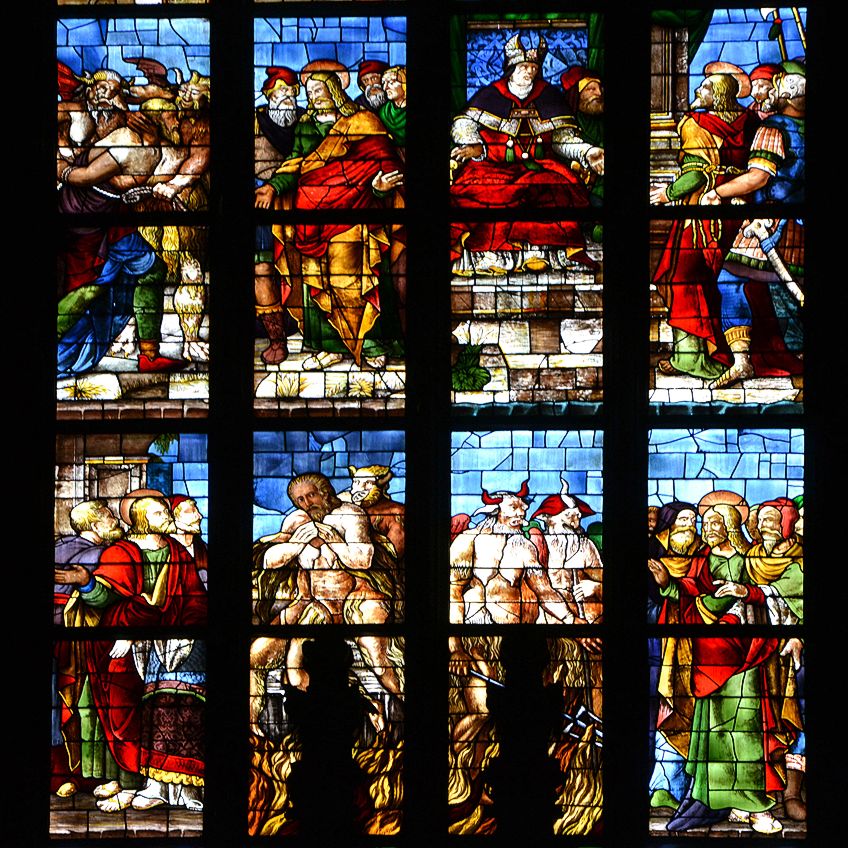 The stained drinking glass window with the Stories of San Giacomo Maggiore, by Corrado de 'Mochis from 1554-1564. Information technology was commissioned by Pius Iv of the Medici di Marignano;Carlo Dell'Orto, CC BY-SA 3.0, via Wikimedia Eatables
The stained drinking glass window with the Stories of San Giacomo Maggiore, by Corrado de 'Mochis from 1554-1564. Information technology was commissioned by Pius Iv of the Medici di Marignano;Carlo Dell'Orto, CC BY-SA 3.0, via Wikimedia Eatables
Famous Medieval Artworks
Equally the Medieval Art menses was one of the oldest art periods to occur, many early on Medieval art and their artists remain unknown to united states. The artworks that have survived throughout the centuries, most notably sculptures and architecture, vest to artists who produced what was considered to be late Medieval art. Additionally, the most notable artists that are spoken about today lived during the latter part of the Medieval period and are thought to overlap with the beginning of the Renaissance.
As about of the fresco paintings did non survive after the stop of the Medieval era, we will exist exploring some of the near notable architectural structures to come up from this flow of creative cosmos.
Hagia Sophia (built in 537 A.D.)
Congenital at the beginning of the Byzantine period within Medieval Art, under the management of Roman emperor Justinian I, the Hagia Sophia was the largest Christian church in being within the Eastern Roman Empire. Originally built equally a Greek Orthodox Christian church, the Hagia Sophie was converted into a mosque in 1453 afterward the fall of Constantinople to the Ottoman Empire. Today, the Hagia Sophia exists every bit a museum in Istanbul, Turkey.
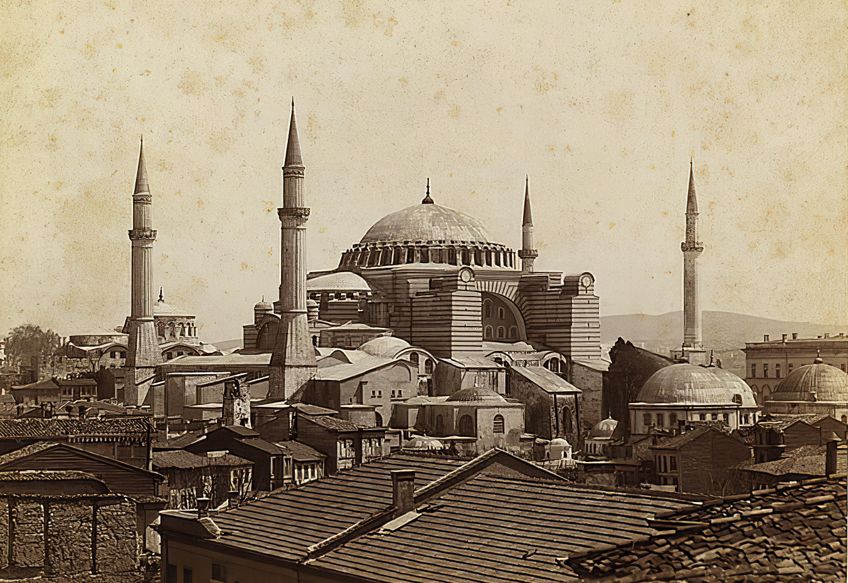 A photograph of the Hagia Sophia, built in 537 A.D.;Ali Rıza Paşa, -1907, photographer, Public domain, via Wikimedia Commons
A photograph of the Hagia Sophia, built in 537 A.D.;Ali Rıza Paşa, -1907, photographer, Public domain, via Wikimedia Commons
Due to its structural pattern, the Hagia Sophia is believed to exist the epitome of Byzantine compages, as it is also one of the greatest surviving architectural examples from this period. At the fourth dimension of its construction, it was considered to exist the earth's tallest building and was well-known for its distinctive and massive dome, as it was the get-go church to ever brand utilise of a fully penetrative dome.
The interior of the structure was originally decorated with rich mosaics and marble pillars that held great artistic value. Being seen as a great achievement of late antiquity, its architectural and eucharistic influence spread throughout both Eastern and Western Christianity and Islam. Today, the Hagia Sophia is a UNESCO Earth Heritage Site.
The Lindisfarne Gospels (written between 715 – 720 A.D.)
Existing as one of the greatest examples of Insular Art, the Lindisfarne Gospels is an illuminated manuscript gospel volume that was written in a monastery in Lindisfarne in North Due east England. This manuscript, which blends Anglo-Saxon, Celtic, and Mediterranean elements, is fabricated up of the four Christian gospels, Matthew, Luke, Mark, and John.
 Folio 27r from the Lindisfarne Gospels, incipit to the Gospel of Matthew. The primary text contains the first sentence of the Gospel According to Saint Matthew: "Liber generationis Iesu Christi filii David filii Abraham" ("The book of the generation of Jesus Christ, the son of David, the son of Abraham");Eadfrith of Lindisfarne (presumed), Public domain, via Wikimedia Commons
Folio 27r from the Lindisfarne Gospels, incipit to the Gospel of Matthew. The primary text contains the first sentence of the Gospel According to Saint Matthew: "Liber generationis Iesu Christi filii David filii Abraham" ("The book of the generation of Jesus Christ, the son of David, the son of Abraham");Eadfrith of Lindisfarne (presumed), Public domain, via Wikimedia Commons
Supposedly mimicking St. Jerome's Latin translation of the Bible, the Gospels recount the life and teachings of Christ. The manuscript is seen equally a great example of Medieval European bookmaking, as information technology was richly illustrated and originally encased in a fine leather bounding that was covered with precious jewels and metals.
Palatine Chapel (congenital betwixt 790 – 805 A.D.)
Located in Germany, the Palatine Chapel was a Medieval chapel that was consecrated by Pope Leo 3 in 805 A.D. to accolade the Virgin Mary. Information technology existed as the outstanding piece of Charlemagne'south Palace of Aachen. While this palace no longer exists today, the preserved chapel now forms part of the Aachen Cathedral. Seen every bit an early on example of Classical, Byzantine, and Pre-Romanesque art, as the architecture combined elements of all iii periods, the Palatine Chapel is an exemplary vision of Middle Ages art.
 A photo of the exterior of Capella Palatina. Palermo, Italy;Liilia Moroz, CC BY-SA four.0, via Wikimedia Commons
A photo of the exterior of Capella Palatina. Palermo, Italy;Liilia Moroz, CC BY-SA four.0, via Wikimedia Commons
The edifice was made upwards of a dome chapel with a square apse and 2 basilican structures that are just known through archaeology, as the original structures have sadly been destroyed. The structure of the dome, which resembled an octagonal cloister vault, borrowed heavily from the Roman period of art through its techniques. Like other structures created in the Medieval menstruum, the Palatine Chapel was designated as a UNESCO Earth Heritage Site, every bit it also now forms function of the Aachen Cathedral.
Notre Dame de Paris (built between 1163 – 1345 A.D.)
Perhaps the nearly well-known Gothic cathedral in beingness is the iconic Notre-Matriarch de Paris, which took over 100 years to exist fully completed. At the beginning of the Medieval era, Notre Dame was considered to exist an incredibly expensive committee of compages. Artworks of this magnitude were only accessibly to large institutions at the fourth dimension, such as the church building, or by the wealthiest of patrons. This late Medieval art structure was declared a UNESCO World Heritage Site in 1991.
Translated to mean "Our Lady of Paris", Notre-Matriarch was sanctified and dedicated to Virgin Mary. The cathedral is also seen as the finest case of Gothic architecture, equally the cathedral pioneered the use of flying buttresses and rib vaults, in add-on to its beautiful stained-glass windows and iconic sculptural elements. Notre Dame differed significantly from the Romanesque style that appeared earlier it due to its distinct fashion and design.
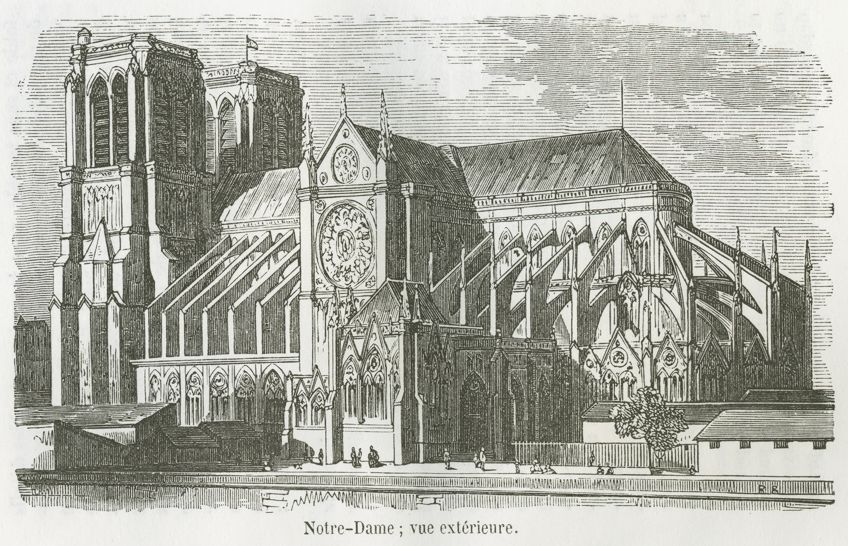 A view of the Cathedral of Notre-Dame, on the Ile de la Cité in Paris, 1855;Brown University Library, Public domain, via Wikimedia Eatables
A view of the Cathedral of Notre-Dame, on the Ile de la Cité in Paris, 1855;Brown University Library, Public domain, via Wikimedia Eatables
The cathedral, which was the site of Napoleon I'due south coronation, gained notoriety in society, as interest in the cathedral sparked after Victor Hugo'southward 1831 publication of The Hunchback of Notre-Dame. While information technology was also adapted into many movies, the nearly notable adaption came from Walt Disney Pictures in 1996.
Since the cathedral'south original construction, it has suffered major damage and dilapidation in the centuries that have gone by. The most recent destruction occurred in 2019 when a massive fire broke out in the cranium of the cathedral and destroyed the 19th-century spire. Two years since this destruction, restorations to rebuild the spire remain underway.
Literature from Middle Ages Art
In addition to artworks, some iconic pieces of literature were also produced during the Medieval period. The majority of the literature coming from the Center Ages was written by monks and religious leaders, as very few other people know how to read and write. Due to this, the available literature was incredibly religious, equally hymns and songs most God were mostly written. However, some leaders wrote philosophical documents about religion, which differed slightly from the typical hymns.
 Saint Marina the Monk presented to the monastery, from Jacobus de Voragine's Legenda aurea (Golden Legend), 14th century, France;Richard de Montbaston, from Jacobus de Voragine, Legenda aurea (traduction de Jean de Vignay), France, Paris, Public domain, via Wikimedia Commons
Saint Marina the Monk presented to the monastery, from Jacobus de Voragine's Legenda aurea (Golden Legend), 14th century, France;Richard de Montbaston, from Jacobus de Voragine, Legenda aurea (traduction de Jean de Vignay), France, Paris, Public domain, via Wikimedia Commons
I of the most notable books coming from the Medieval era, which told stories about Saints during this time menstruation, was the Gold Legend. The book was written past the archbishop of Genoa, Jacobus de Voragine, betwixt 1259 and 1266. Some other secular books were written too, but the more religious literature pieces proved to be more than popular.
While organized religion influenced the majority of the literature produced, some famous non-religious literary works were too written. Some of these works include The Canterbury Tales by Geoffrey Chaucer and The Divine Comedy by Dante Alighieri to proper name a few. These literary masterpieces, which are still spoken about today, take managed to withstand the examination of time and exist equally some of the almost iconic writings that were produced during the Medieval Art period.
The starting time of the Renaissance period signaled an end to Medieval Art and saw a render to the values of classical art and a renewed understanding of the features within the Middle Ages art. While the Medieval era was more often than not thought of as a dark menstruum in history, its contribution has influenced the many unlike fine art styles that exist today. Due to its all-encompassing time frame, Medieval Art experimented with a diversity of genres that helped broaden its range, which has allowed the movement to stand every bit evidence to the progression of art.
Take a await at our Middle Ages art webstory here!
cranwellhincture1985.blogspot.com
Source: https://artincontext.org/medieval-art/